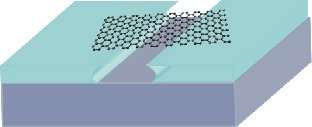February 20, 2008 feature
Graphene Takes the Heat

Carbon nanotubes are being touted by many scientists and engineers as the material of the future, with the potential to revolutionize electronic technologies. But a new study shows that nanotubes may not be the only form of carbon with the promise of great things to come.
Researchers from the University of California – Riverside (UCR) discovered that a single layer of carbon atoms arranged in a honeycomb pattern, known as graphene, exhibits far better thermal conductivity than carbon nanotubes. Their results open a new window to graphene applications in electronics, where materials that can manage heat are vital.
The group's results are described in a paper appearing in the February 20, 2008, online edition of Nano Letters.
“With the continuously decreasing size of electronic devices, materials that can conduct heat efficiently are rapidly growing in importance,” said the paper's lead author, UCR electrical engineering professor Alexander Balandin, to PhysOrg.com. “Our work increases the range of graphene applications as the thermal management material in optoelectronics, photonics, and bioengineering.”
A material's thermal conductivity is measured in the units W/m•K, read as “watts per meter per degree Kelvin.” A watt is a unit of power equal to a joule per second and a degree Kelvin is a unit of temperature. The meter is, of course, a unit of distance, since thermal conductivity is normalized to the material's thickness. Thermal conductivity defines how well a given material conducts heat. For example, the value of thermal conductivity of silicon, the most important electronic material, is around 145 W/m•K if measured at room temperature.
Carbon nanotubes have a typical thermal conductivity range of 3000 to 3500 W/m•K. Diamond, another form of carbon, comes in between 1000 and 2200 W/m•K. The single-layer graphene studied by the UCR researchers displayed a thermal conductivity as high as 5300 W/m•K near room temperature.
“Graphene is particularly promising as a thermal management material because its superior thermal conductivity is supplemented by plane geometry and good integration with silicon,” added Balandin.
The interdisciplinary UCR team, which included research groups of electrical engineering professor Balandin and physics assistant professor Chun Ning Lau, measured the graphene's thermal conductivity in an unconventional way. The usual contact-based methods for measuring thermal conduction are not appropriate for graphene because it is only a single atom thick. Instead, the group used a noncontact approach: They placed a sheet of graphene onto a substrate with a trench carved out of it, such that part of the graphene sheet was suspended over the trench. They then scattered laser light off the suspended portion and measured the graphene’s vibrational response with a technique called Raman spectroscopy (one of several light-based methods used to learn about material properties).
By carefully analyzing the graphene's Raman spectra – its unique response to the light – and the spectra's dependence on the laser power, the group was able to extract thermal conductivity data. The entire experimental setup is tiny, with the trench just three micrometers (millionths of a meter) in width.
Citation: Nano Lett. ASAP Article, 10.1021/nl0731872
Copyright 2008 PhysOrg.com.
All rights reserved. This material may not be published, broadcast, rewritten or redistributed in whole or part without the express written permission of PhysOrg.com.




















